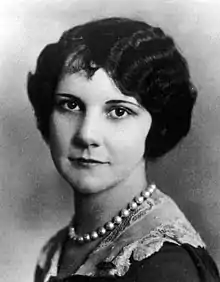Grace Fryer
Grace Fryer (14 March 1899 – 27 October 1933)[1] was an American dial painter and Radium Girl,[2] who sued U.S. Radium after suffering radium poisoning while employed painting watch faces.[3] Subsequently, joined by fellow workers Quinta McDonald, Albina Larice, Edna Hussman, and Katherine Schaub, Fryer brought a suit labelled in the media “The Case of the Five Women Doomed to Die”.[4][5] It was a pivotal case for the labor rights movement and in establishing workers' safety regulations.[6][7]
Grace Fryer | |
|---|---|
 | |
| Born | 14 March 1899 Morris County, New Jersey, USA |
| Died | 27 October 1933 (aged 34) Essex County, New Jersey, USA |
| Resting place | Restland Memorial Park, East Hanover, Morris County, New Jersey, USA |
| Occupation(s) | Dial painter, bank teller |
| Employer | United States Radium Corporation |
| Known for | Bringing a lawsuit against the US Radium Corporation |
Early life
Grace Fryer was born on 14 March 1899 in Orange, New Jersey, one of eleven children born to Daniel Edward Fryer and Grace Moulton Gilbert.[8][1] Her father was a union representative.[9]
Fryer began working at U.S. Radium in 1917 aged eighteen and left in January 1920, having been offered work as a bank teller.[3][10][11] Alongside 70 other women and girls, Fryer worked painting the faces of watches, clocks, and other instruments with a glow-in-the-dark radium solution.[11] To maintain a thin point on the brushes they used, workers were encouraged to "point' them using their lips, which they did regularly as they worked.[3][11][12]
Lawsuit against U.S. Radium
.jpg.webp)
Within two years of leaving U.S. Radium, Fryer began losing her teeth.[13] Soon afterwards, her jaw became painful and her eyes clouded.[13][11] A doctor discovered serious bone decay in her mouth, but failed to identify a reason for it.[13] It wasn't until 1925 that a second doctor suggested Fryer's health issues might relate to her previous employment.[3][13]
Having sought a lawyer willing to take the case for two years,[10] in May 1927, assisted by young attorney Raymond Berry, Fryer filed a lawsuit with the New Jersey Supreme Court.[2] She was subsequently joined by four other dial painters: Quinta McDonald, Albina Larice, Edna Hussman, and Katherine Schaub.[2] McDonald and Larice were sisters of Amelia Maggia, who had been the first known victim of chronic industrial radium poisoning.[2] She had died in 1922.[2]
The situation of the so-called "doomed women" aroused the sympathies, and outrage, of the press.[3] The Woman's Journal wrote in 1928:
Seldom have we had so flagrant an instance of the heartlessness of a great corporation. It proves again that while ninety-nine employers may provide the best of care for those who labor for them, the public must safeguard the weak and helpless who are at the mercy of the hundredth master—not alone by wider education about industrial hazards, but by the most careful and stringent laws.[14]
Fryer has been described as spearheading the "long, arduous fight" for acknowledgement of "the deadly repercussions of using radium", and the demand for compensation for the women affected.[7] The 'Radium Girls' won their lawsuit in 1939, with U.S. Radium ruled responsible for their radium poisoning.[9][10]
Death and legacy
Grace Fryer died on 27 October 1933 at the age of 34.[1] Today, the Horological Society of New York awards The Grace Fryer Scholarship for Female Watchmaking Students, named for Fryer and the Radium Girls.[7][15]
References
- "Grace Fryer (1899-1933)". Find a Grave Memorial. Retrieved 2022-09-16.
- Dewar, Dale (2014). From Hiroshima to Fukushima to you : a primer on radiation and health. Internet Archive. Toronto, Ontario : Between the Lines. ISBN 978-1-77113-127-8.
- Clark, Claudia (1997). Radium girls, women and industrial health reform : 1910-1935. Internet Archive. Chapel Hill, NC : University of North Carolina Press. ISBN 978-0-8078-2331-6.
- Wishart, Adam (2007). One in three : a son's journey into the history and science of cancer. Internet Archive. New York : Grove Press : Distributed by Publishers Group West. ISBN 978-0-8021-1840-0.
- Mullner, Ross M. (1999). Deadly glow : the radium dial worker tragedy. Internet Archive. Washington, DC : American Public Health Association. ISBN 978-0-87553-245-5.
- "Factory Workers Who Fought Back | BU Today". Boston University. Retrieved 2022-09-16.
- "HSNY Announces the Grace Fryer Scholarship for Female Watchmaking Students". Horological Society of New York. Retrieved 2022-09-16.
- "The Girls | The Radium Girls". The Radium Girls. Retrieved 2022-09-16.
- Keating, Shea (2021-07-26). "Grace Fryer: Women of History". Medium. Retrieved 2022-09-16.
- "Radium girls". Environmental history. 2012-07-20. Retrieved 2022-09-16.
- Neuzil, Mark (1996). Mass media & environmental conflict : America's green crusades. Internet Archive. Thousand Oaks, Calif. : Sage Publications. ISBN 978-0-7619-0332-1.
- Grady, Denise (1998-10-06). "A Glow in the Dark, and a Lesson in Scientific Peril". The New York Times. ISSN 0362-4331. Retrieved 2022-09-16.
- Emling, Shelley (2012). Marie Curie and her daughters : the private lives of science's first family. Internet Archive. New York : Palgrave Macmillan. ISBN 978-0-230-11571-2.
- The Woman's Journal 1928-06: Vol 13 Iss 6. Internet Archive. Open Court Publishing Co. 1928.
{{cite book}}: CS1 maint: others (link) - "Grace Fryer Scholarship". Horological Society of New York. Retrieved 2022-09-16.